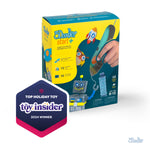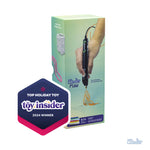STEM: 2D vs 3D Bubble Wands
Learners will plan and create a two dimensional bubble wand using 3Doodler pens. They will test their wand to see the shape, size and number of the bubbles that come out. They will then create a three dimensional shaped bubble wand and see if that changes the bubble sizes, shapes, and quantities.

KnowledgeStudents havehad experience using the 3Doodler Start pens
reviewed what a hypothesis is
had experience using the 3Doodler Start pens
reviewed what a hypothesis is
ObjectivesStudents willcreate a hypothesis on what they think the different outcomes will be with the 2D and 3D Bubble Wands
create a 2D bubble wand, observe quantity and size of bubbles
create a 3D bubble wand, observe quantity and size of bubbles
compare the results of using each of the bubble wands
create a hypothesis on what they think the different outcomes will be with the 2D and 3D Bubble Wands
create a 2D bubble wand, observe quantity and size of bubbles
create a 3D bubble wand, observe quantity and size of bubbles
compare the results of using each of the bubble wands
MaterialsStudents will need3Doodler Start Filaments (4 Strand limit per student per bubble wand)
3Doodler Start Filaments (4 Strand limit per student per bubble wand)
Lesson PlanInstructions
Step 1Share the goal: Learners will create 2D and 3D Bubble wands and compare the results of the quantity and size of bubbles from each. Let them know they will first discuss
Before beginning, remind students what the definition of a "hypothesis" is. Then, have an open discussion with students about their varying hypotheses for the difference in quantity and size of bubbles from each bubble wand. Which wand do they think will yield more bubbles, and why? Which wand will yield larger bubbles, and why? Are there any other variables they can think of that may impact the size and shape of the bubbles from their 2D and 3D wands?
Step 2Give students the planning sheet, and let them know this is for the 2D Bubble Wand. Have them brainstorm ideas as a class or in small groups about bubbles and bubble wands.
Step 3Have students find a partner or two and gather critical input about their 2D Bubble Wand plan.
Step 4Next, explain the concepts of creating in 3D with the 3Doodler Start pens. Show them how to create a 2D shape, then how to add onto it and make it 3D. Also speak to the amount of filament they will need to create a strong design. For example, they can layer the filament to make the structure stronger.
Have them work on their second Bubble Wand design, which will be 3D. Have them go through the same design process with pencil on the worksheet, then get feedback from peers on the design.
Step 5Once both Bubble Wand plans are complete, have them get their supplies and begin.
Note: You may put a size limit on the project also, knowing you have limited time and possibly limited supplies. (Suggested strand limit: 8 total strands for both wands, or 4 strands per wand.)
Step 6Circle the class to assist as students use the 3Doodler pens to create their 2D and 3D Bubble Wands. Provide assistance as necessary.
TIP: Each pen, even if “unloaded” has a bit of the last color of filament. Have students use this to start the structure for their bubble wand handle. You get what you get and you don’t have a fit - you use it.
Step 7Testing phase: Have students each use their bubble wands and fill out the information on their sheet. Have them note differences in the sizes and quantities of the bubbles. Encourage discussions as students test their bubble wands.



Share the goal: Learners will create 2D and 3D Bubble wands and compare the results of the quantity and size of bubbles from each. Let them know they will first discuss
Before beginning, remind students what the definition of a "hypothesis" is. Then, have an open discussion with students about their varying hypotheses for the difference in quantity and size of bubbles from each bubble wand. Which wand do they think will yield more bubbles, and why? Which wand will yield larger bubbles, and why? Are there any other variables they can think of that may impact the size and shape of the bubbles from their 2D and 3D wands?
Give students the planning sheet, and let them know this is for the 2D Bubble Wand. Have them brainstorm ideas as a class or in small groups about bubbles and bubble wands.
Have students find a partner or two and gather critical input about their 2D Bubble Wand plan.
Next, explain the concepts of creating in 3D with the 3Doodler Start pens. Show them how to create a 2D shape, then how to add onto it and make it 3D. Also speak to the amount of filament they will need to create a strong design. For example, they can layer the filament to make the structure stronger.
Have them work on their second Bubble Wand design, which will be 3D. Have them go through the same design process with pencil on the worksheet, then get feedback from peers on the design.
Once both Bubble Wand plans are complete, have them get their supplies and begin.
Note: You may put a size limit on the project also, knowing you have limited time and possibly limited supplies. (Suggested strand limit: 8 total strands for both wands, or 4 strands per wand.)
Circle the class to assist as students use the 3Doodler pens to create their 2D and 3D Bubble Wands. Provide assistance as necessary.
TIP: Each pen, even if “unloaded” has a bit of the last color of filament. Have students use this to start the structure for their bubble wand handle. You get what you get and you don’t have a fit - you use it.
Testing phase: Have students each use their bubble wands and fill out the information on their sheet. Have them note differences in the sizes and quantities of the bubbles. Encourage discussions as students test their bubble wands.



Wrap Up
Assessment
Possible Extensions
Resources
Science Buddies on Creating a Strong Hypothesis
Lesson and images courtesy of Velvet Holmes
Vocabulary
hypothesis - a supposition or proposed explanation made on the basis of limited evidence as a starting point for further investigation.
variable - not consistent or having a fixed pattern; liable to change.
Educational Standards
Students use critical thinking skills to plan and conduct research, manage projects, solve problems, and make informed decisions using appropriate digital tools and resources: Collect and analyze data to identify solutions and/or make informed decisions
Students brainstorm hypotheses, plan their 3D project, then use the 3Doodler pens to create their 2D and 3D bubble wands. Students can refine their work as needed.
Students communicate complex ideas clearly and effectively by creating or using a variety of technology to create visualizations, models or simulations.
Students create 2D and 3D bubble wands through planning in advance on their worksheet and then creating them using the 3Doodler pens.
Plan and create a design document to illustrate thoughts, ideas, and stories in a sequential (step-by-step) manner (e.g., story map, storyboard, sequential graphic organizer).
Students will brainstorm ideas and sketch designs for their 2D and 3D bubble wands, then bring them to life in 3D with the 3Doodler pens.
Decompose (break down) a larger problem into smaller sub-problems with teacher guidance or independently.
Students will break down the process into brainstorming, designing, building, and discussing their project with the class.





